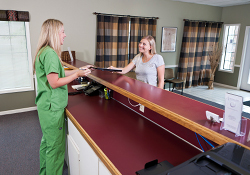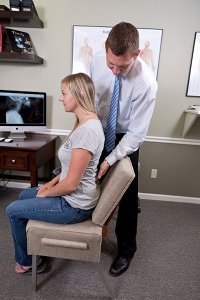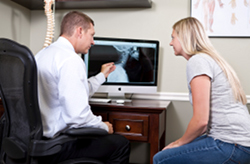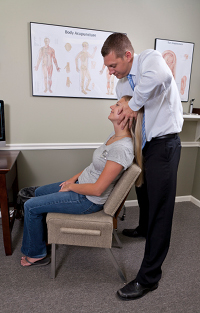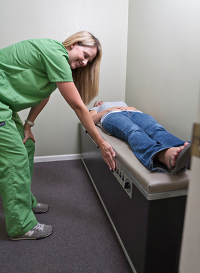On your first visit to our office you will be welcomed with a warm smile by our caring staff. If you haven’t already, they will ask you to fill out the initial paperwork, which gives us some information about yourself and your specific condition, as well as obtain any additional information needed.
Consultation
After your paperwork is complete, you will meet with the doctor. The first thing the doctor will do is sit down and talk with you about your condition and get a complete history in order to fully understand your condition. If your car breaks down you explain to a car mechanic what problems you are having with your car. The mechanic also asks you what type of fuel you’re putting in your car. Likewise, the doctor wants to know what kind of problems or discomfort you have been experiencing and how you are fueling you body. Automobile accidents, falls, other traumas or injuries are important information in evaluating your spine and overall health. Once the doctor has a good understanding of your condition he can determine if it will respond to chiropractic care and if so discern the best way to treat it.
Chiropractic Neurological and Orthopedic Exam
Once the history has been completed, the doctor will perform a thorough chiropractic orthopedic and neurological examination. The examination will include specific chiropractic orthopedic and neurological tests to assess range of motion, muscle tone, muscle strength, neurological integrity as well as try to reproduce your pain in order to better understand the cause. Based on these procedures, further tests may be necessary to arrive at the assessment or diagnosis of the affected area.
X-Rays
Based upon your exam findings, the doctor may feel that x-rays are needed. The doctor may perform a full spine series of x-rays or a limited series based upon your exam findings and individual need.
Report of Findings
The report of findings is typically done the following visit, this is in order to give the doctor ample time to look over all of his findings. This is where the doctor will explain, in easy to understand terms, your diagnosed condition and how he will treat the condition. A treatment program will be outlined and explained as well. If the doctor believes that your condition cannot benefit from chiropractic care, you will be recommended to a physician that should be consulted.
Adjustments
Before each treatment, the doctor will examine your spine to find out what vertebra needs to be adjusted and even if it needs to be adjusted that day. He will then apply a specific Gonstead adjustment to any area necessary. The adjustment is the most beneficial treatment you will receive in our office and is when normal biomechanical motion is restored to the spine. The doctor will use carefully directed, controlled and specific thrusts to return malpositioned spinal bones to their proper motion and position, reducing nerve interference. The adjustment is a quick, painless maneuver that every patient receives. We have a wide variety of patients at our office, from infants to the elderly, and all of our treatments are tailored around each individual patient. The adjustment itself is gentle enough for kids, yet able to restore function and movement for the athlete and senior.
Electrical Acupuncture
The doctor may decide to include acupuncture in your treatment. Instead of using needles to treat acupuncture points, the doctor will typically use electronic stimulation called microcurrent to treat the points. The doctor may also use a Teishin, also known as a non-piercing needle. With these methods treatment is more comfortable, and we don’t have to worry about the risk of infection. You also don’t need to spend 30 minutes with needles in various parts of your body. The results are just as good, even better according to many experts. Acupuncture points may also be stimulated with massage, pinching, percussion, heat, cold laser, and many others as well if needed.
Therapy
The doctor may also recommend therapy which will typically be applied before the adjustment on future visits. This may include intersegmental traction which is a way of inducing passive motion into the spine which will stretch spinal joints and increase mobility and flexibility in the spine as well as create a pumping action in the discs. The most important thing it does is keeps the disc healthy by getting it the nutrients it needs to prevent degeneration. The patient lies face up on the IST table which has rollers beneath its surface that slowly travel the length of the spine.



